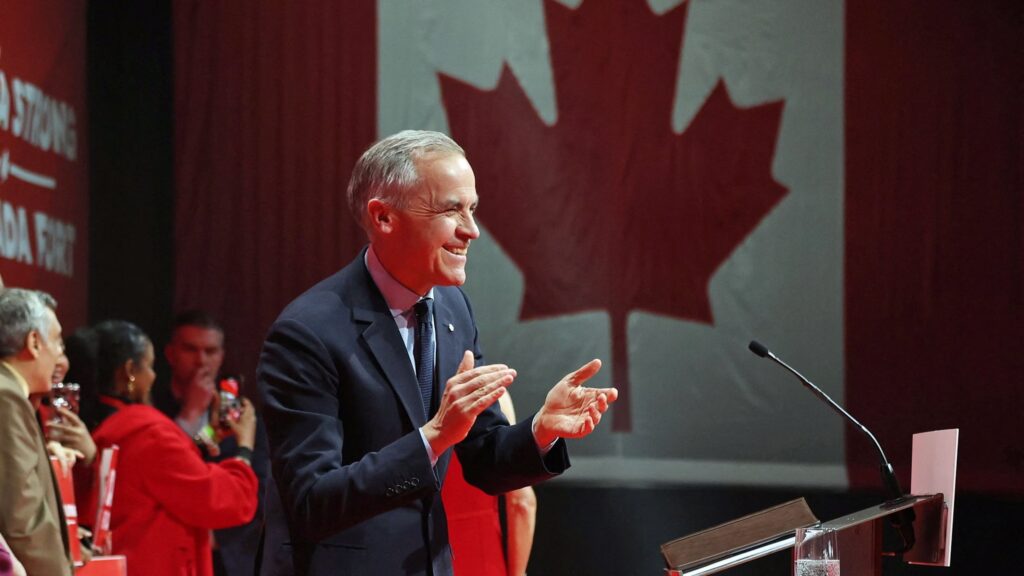April 29, 2025 — Canada has officially elected former Bank of Canada and Bank of England Governor Mark Carney as Prime Minister. While his win is seen as a “safe pair of hands” by global markets, the stock market’s muted reaction tells a deeper story.
Investors are cautiously optimistic, but the upside would have been far more aggressive had Conservative leader Pierre Poilievre secured victory.
Here’s what investors need to know about today’s market behavior — and the opportunity cost of the alternative outcome.
Market Reaction to Carney’s Victory: Cautious, Not Euphoric
The S&P/TSX Composite Index rose 0.1% today, a modest gain that reflects cautious optimism rather than a full-blown rally. Financials led the gains, while energy and industrials showed mixed performance.
Why the Tepid Response?
- Policy Stability, But Bigger Government:
Carney brings international credibility and policy expertise, especially valued during times of economic uncertainty. However, his platform leans toward higher corporate taxation, increased regulatory oversight, and more aggressive climate mandates. These measures are traditionally viewed as headwinds for corporate profitability — particularly for resource, energy, and financial sectors that dominate the TSX.
- Minority Government = Gridlock Risk:
Carney’s Liberals secured only a minority government, meaning they will have to collaborate with the NDP or Bloc Québécois to pass legislation. This raises the likelihood of left-leaning concessions, such as expanded social programs or tighter environmental regulations — both potential drags on business margins.
- External Headwinds Remain:
Regardless of leadership, Canada’s heavy dependence on U.S. economic health, global commodity prices, and interest rate trends means macro risks overshadow any domestic political outcome.
🆚 Direct Comparison: Carney vs Poilievre Investment Sector Impacts
| Sector | Carney Likely Impact | Poilievre Likely Impact | Key Difference |
|---|---|---|---|
| Financials (Banks) | Mild Positive | Strong Positive | Poilievre would create a much more favorable banking environment (lower taxes, deregulation). |
Energy (Oil & Gas) | Mixed to Negative | Very Positive | Carney likely tightens environmental rules; Poilievre would unleash energy exports. |
| Green Energy | Positive | Neutral to Slight Negative | Carney boosts green energy with subsidies; Poilievre focuses less on government-driven climate policy. |
| Infrastructure | Mild Positive | Positive | Carney spends on green infrastructure; Poilievre on energy/transport infrastructure with less red tape. |
| Mining (Gold, Copper, Critical Minerals) | Positive | Very Positive | Carney supports only critical minerals; Poilievre would fast-track all resource development. |
| AI & Tech | Mild Positive | Positive | Carney supports innovation but regulates; Poilievre deregulates and incentivizes faster. |
| Technology (Broad) | Mild Positive | Positive | Similar to AI — Poilievre’s hands-off approach would drive more upside. |
| Real Estate (REITs, Developers) | Mixed | Positive | Carney may prioritize affordability measures; Poilievre would favor free-market development. |
Notes
- Mining could actually do very well under Carney, but only for critical minerals (like lithium, copper, nickel) — not coal or heavy-emission projects.
- AI and Tech will be moderately supported, especially anything green, health-tech, or climate-related. But Carney is not a “tech deregulator” like Poilievre would have been.
- Real Estate depends heavily on the Bank of Canada’s monetary policy path (not just federal leadership), but Carney’s focus on affordability might help multi-unit (apartments) while hurting luxury housing developers.
What Could Have Happened if Poilievre Had Won?
Investors were closely watching for a potential Conservative majority under Pierre Poilievre — a scenario that would likely have sent the TSX into a strong rally.
Here’s why:
Deregulation and Pro-Business Agenda:
Poilievre’s platform prioritized cutting red tape, lowering corporate taxes, and accelerating energy project approvals. Investors would have priced in higher profitability across banking, mining, and energy sectors almost immediately.
Energy Sector Supercharge:
Poilievre was vocally supportive of Canada’s oil sands and LNG projects. With energy representing about 20–25% of the TSX Composite Index, a Conservative win would have likely ignited a broad rally across major Canadian producers like Canadian Natural Resources (CNQ), Suncor (SU), and Tourmaline Oil (TOU).
Majority Government Certainty:
Markets reward clarity. A majority Conservative government would have reduced policy uncertainty, allowing businesses to plan investments confidently — another trigger for an upward market re-rating.
Investment Takeaways
📚 Summary
| Theme | Under Carney | Under Poilievre |
|---|---|---|
| Government Role in Economy | Expanding | Shrinking |
| Corporate Tax Trend | Higher risk | Lowering likelihood |
| Regulatory Burden | Rising (especially climate) | Falling |
| Energy Sector Outlook | Neutral/Negative | Strong Bullish |
| Tech Sector Outlook | Moderate | Bullish |
| Real Estate Outlook | Mixed, policy-driven | Growth-friendly |
✍️ Interpretation for Investors:
- Carney’s government favors stability, climate transition, and selective sector growth (financials, green energy, critical minerals).
- Poilievre’s government would have fueled a broad-based, pro-growth rally — especially in financials, energy, mining, tech, and real estate.
In the Short Term:
Expect the Canadian market to drift sideways to moderately higher. Financials and green energy sectors could outperform, while traditional energy and high-emission industries may face headwinds.
In the Medium Term (6–12 Months):
Investor focus will shift toward fiscal policy details. If Carney governs moderately and avoids heavy new taxes, the TSX could grind higher. However, any tilt toward aggressive spending and regulation could cap returns.
If You Are Positioning Now:
Overweight
Financials with global exposure, clean tech, infrastructure builders.
Underweight
Pure oil sands plays, smaller-cap energy developers, highly regulated industries.
Watchlist:
Look for any signals of corporate tax hikes or major ESG mandates — these would be major catalysts for sector rotation.
Final Thoughts
Mark Carney’s win offers stability but limits immediate upside. In contrast, a Poilievre win could have triggered a sharp, multi-sector rally driven by deregulation, corporate tax cuts, and energy expansion. For investors, the path ahead under Carney will require selective positioning, sector discipline, and close monitoring of fiscal signals from Ottawa.
Stay tuned to InvestorStockPicks.com for deeper sector reports and tactical plays as Canada’s new political landscape unfolds.



